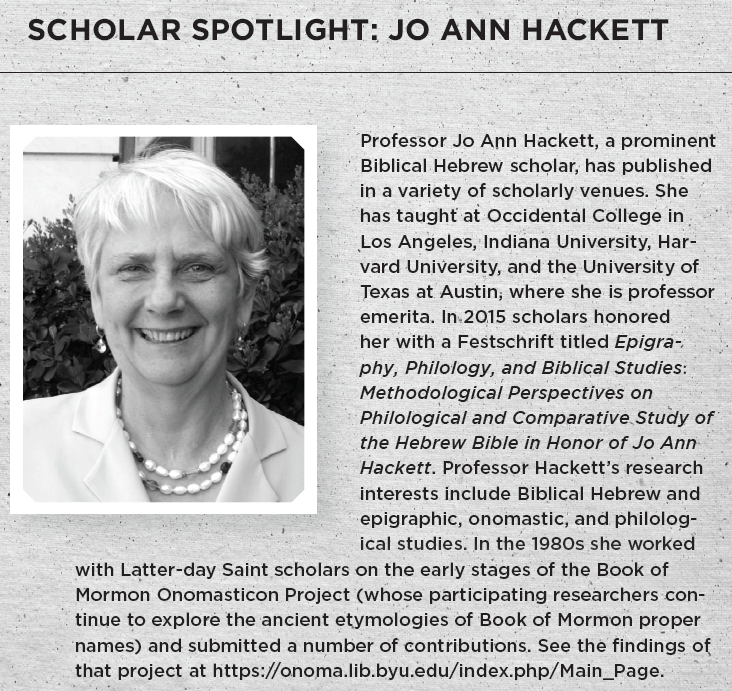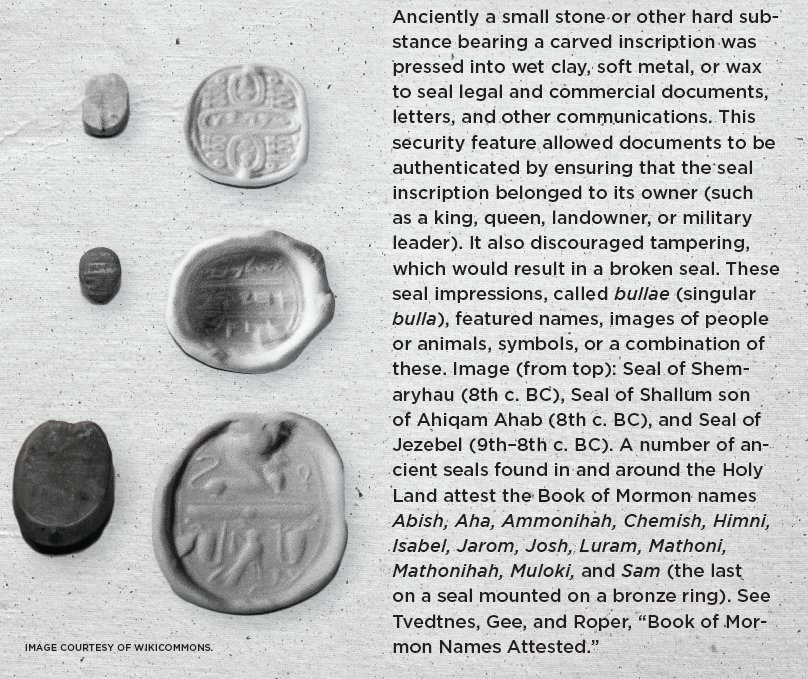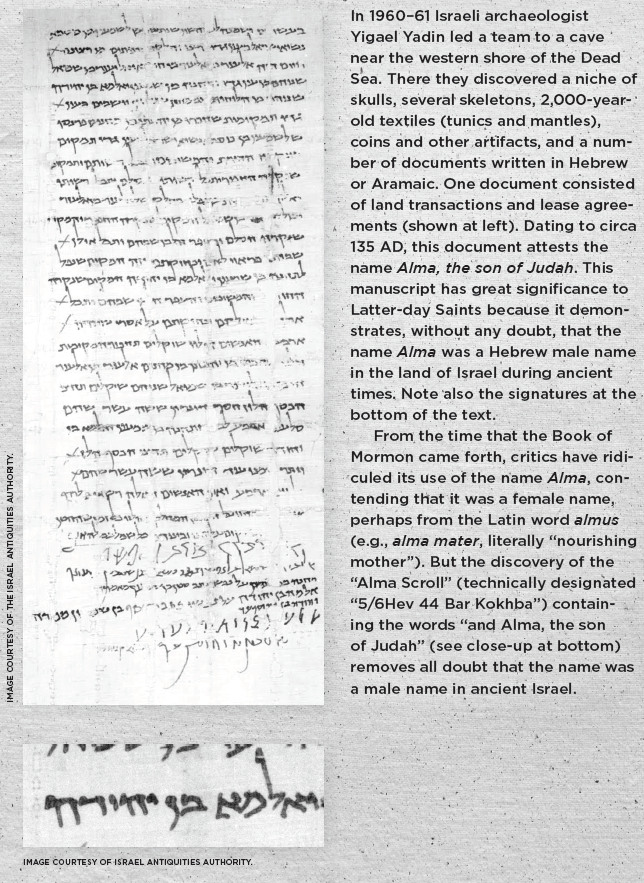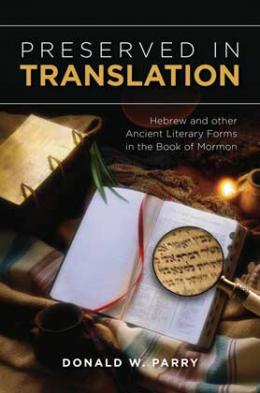The Witness of Ancient Inscriptions
Donald W. Perry, “The Witness of Ancient Inscriptions,” in Preserved in Translation: Hebrew and Other Ancient Literary Forms in the Book of Mormon (Provo, UT: Religious Studies Center, Brigham Young University; Salt Lake City: Deseret Book), 129‒36.
attested proper names—from Abish to Sariah
In 1950 Latter-day Saint scholar Hugh Nibley pulled together a list of Book of Mormon proper names that had a striking resemblance to names from the ancient Near East, including Egypt.[1] He later expanded on his list in two subsequent publications, one in 1964 and the other in 1967.[2] His groundbreaking work opened the door to further research by subsequent scholars. One important study found clear evidence that several Book of Mormon names existed in ancient Israel.[3] These names, which do not appear in the Bible, include Abish, Aha, Alma, Chemish, Hagoth, Himni, Isabel, Jarom, Josh, Luram, Mathoni, Mathonihah, Muloki, Sam, and Sariah. They have been discovered in various ancient Hebrew inscriptions from the Holy Land and surrounding areas—on papyri, seals, ostraca (pieces of pottery), bronze arrowheads, and clay bullae (seal impressions).[4] As these scholars explain:
In recent years, a large number of ancient writings have been found in and around Israel. While many of these include names found in the Bible and other ancient texts, others were previously unattested in written sources. Some of these previously unattested names are unknown in the Bible but are found in the Book of Mormon. The discovery of these Hebrew names in ancient inscriptions provides remarkable evidence for the authenticity of the Book of Mormon and provides clear refutation of those critics who would place its origin in nineteenth-century America.[5]

The discovered names are written in Hebrew, of course, and not English. Ancient Hebrew consists of consonants only, so ancient readers had to “mentally add the vowels according to the context of the words—which is still the case in modern Hebrew. The vowels found in medieval Hebrew Bible scrolls and in modern printed Hebrew Bibles were supplied by later scribes.”[6] Thus the following names, all discussed in the article referenced above, are represented only by their consonants in the ancient Hebrew inscriptions.
Abish—a Lamanite woman, servant to a queen (see Alma 19:16).[7] “Abish corresponds to the Hebrew name ʾbšʾ, found on a seal from pre-exilic times (prior to 587 BC) in the Hecht Museum in Haifa.”[8] The date of 587 BC, as we recall, was around the time of Lehi.
Aha—a son of a military leader named Zoram (see Alma 16:5); Aha is found in several inscriptions.
Alma—the name of two leading personalities from the Book of Mormon. Significantly, Israeli scholar Yigael Yadin transliterates the Hebrew form of this name to read Alma.[9]
Chemish—a custodian of the small plates of Nephi (see Omni 1:8–10); his name is found on an ancient seal.
Hagoth—a Nephite shipbuilder (see Alma 63:5); his name appears on an Ammonite seal that predates the exile of the Israelites (about 587 BC).
Himni—one of Mosiah’s four sons (see, for example, Mosiah 27:34 and Alma 22:35); his name is found on two Israelite seals, both of which predate the time of Lehi.
Isabel—a harlot (see Alma 39:3); her name is written on a seal.
Jarom—a son of Enos and grandson of Jacob (Nephi’s brother; see Jarom 1:1, 14). Yrm is found in four Hebrew inscriptions—a jug inscription, seal, ostracon, and clay bulla.
Josh—the name of a military leader (see Mormon 6:14) and a city (see 3 Nephi 9:10); the name is recorded on several ancient inscriptions, including three letters (from Lachish), papyri from the Elephantine Jewish community, and four clay bullae from Tel Beit Mirsim.
Luram—the name of a military leader (see Moroni 9:2); Luram is found on an eighth-century-BC seal from Hamath, Syria, and also on some ancient graffiti.
Mathoni—the name of one of Jesus’s twelve disciples (see 3 Nephi 19:4). For more on this name, see its variation, Mathonihah.
Mathonihah—the name of one of Jesus’s twelve disciples (see 3 Nephi 19:4). Mathoni is probably a shortened form of Mathonihah, which has the suffix -ihah. “Mtn, which could be vocalized either Mattan (as in the Bible) or Mathoni (as in the Book of Mormon), is found on Ostracon 1682/

Muloki—a missionary to the Lamanites (see Alma 20:2; 21:11). The name Mlky, discovered on a clay bulla in Jerusalem (City of David), dates to the general time of Lehi.
Sam—Nephi’s brother and Lehi and Sariah’s son (see 1 Nephi 2:5). The name Sam was found on a bronze seal that dates to the century before Lehi.
Sariah—the name of Lehi’s wife, found on a papyrus belonging to a Jewish community in Elephantine, Egypt, in the fifth century BC. The name has also been discovered on clay bullae and seals.[11] Similar to some modern names in the English language, certain ancient names—such as Abijah, Solomon, and Sariah —were used for both males and females.[12] Neal Rappleye has called our attention to an ostracon from Elephantine that “contains a sure attestation of the name ŚRYH [Seraiah/
Notes

[1] See Nibley, Lehi in the Desert, 27–36.
[2] See Nibley, Approach to the Book of Mormon, 230–42; and Nibley, Since Cumorah, 168–72.
[3] See Tvedtnes, Gee, and Roper, “Book of Mormon Names Attested in Ancient Hebrew Inscriptions,” 40–51, 78–79. The authors state in footnote 1 that “all the names attested in this article can also be found in G. I. Davies, Ancient Hebrew Inscriptions: Corpus and Concordance (Cambridge: Cambridge University Press, 1991).” Tvedtnes, Gee, and Roper include additional important bibliographic items that support the different names treated in their article.
[4] Ancient seals bore a name or symbol carved in stone or a similar surface; the seal was used to impress the name or symbol onto clay or wax. A bulla (plural bullae) is the seal impression itself on clay or wax. An ostracon (plural ostraca) is a fragment of pottery bearing an inscription.
[5] Tvedtnes, Gee, and Roper, “Book of Mormon Names Attested,” 42.
[6] Tvedtnes, Gee, and Roper, “Book of Mormon Names Attested,” 43.
[7] For recent studies on the name Abish, see Bowen, “Father Is a Man”; and Welch et al., “Why Was Abish Mentioned by Name?,” 294–95.
[8] Tvedtnes, Gee, and Roper, “Book of Mormon Names Attested,” 46. As stated above, ancient Hebrew consists of consonants and not vowels; therefore we cannot be absolutely certain that ʾbšʾ is equivalent to Abish.
[9] Yadin, Bar Kokhba, 176. Hugh Nibley has also written regarding the name Alma in Nibley, Prophetic Book of Mormon, 281–82. For more recent scholarship, see Hoskisson, “Alma as a Hebrew Name,” 72–73; and Szink, “Further Evidence of a Semitic Alma.” Some commentators have held the opinion that the name Alma in the Book of Mormon was related to the Hebrew word ‘almah (“young woman”), but in the Bar Kokhba text, Alma (also written in Hebrew) has a different spelling.
[10] Tvedtnes, Gee, and Roper, “Book of Mormon Names Attested,” 51.
[11] For the name Sariah, see the two significant studies by Jeffrey R. Chadwick: “Sariah in the Elephantine Papyri” and “Names Lehi and Sariah—Language and Meaning.” Tvedtnes, Gee, and Roper also observe that the name Sariah “is known from three seals . . . and two bullae,” 78n1. They provide the following sources: Avigad, “New Names on Hebrew Seals”; Avigad, “Seal of Seraiah (Son of) Neriah”; Avigad and Sass, Corpus of West Semitic Stamp Seals, 91; and Avigad, Hebrew Bullae from the Time of Jeremiah, 46–47, 103–4.
[12] See Tvedtnes, Gee, and Roper, “Book of Mormon Names Attested,” 43.
[13] Rappleye, “Revisiting ‘Sariah’ at Elephantine,” 1. For an important summary of scholarship on the name Sariah, see Welch et al., “Were There Ancient Israelite Women Named Sariah?”
